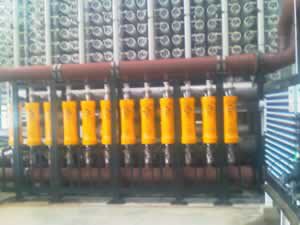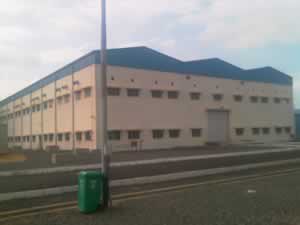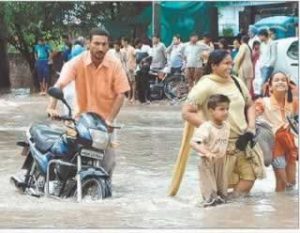“If you continually write out cheques without depositing anything in your bank account, you will run out of money. So It is with your life. Without regular deposits of peace in your life account, you will run out of strength, calmness, and happiness. You will finally become bankrupt—emotionally, mentally, physically, and spiritually. But daily communion with God will continually replenish your inner bankroll. ”
— Paramahansa Yogananda
Peace
Affirm divine calmness and peace, and send out only thoughts of love and goodwill if you want to live in peace and harmony. Live a godly life yourself and everyone who crosses your path will be helped just by being with you.
—Paramahansa Yogananda, SRF Lessons
India’s Leap Forward : Country’s Largest Desalination Plant Opens in Chennai
| CHENNAI | STATISTICS |
|
Geographical Area |
175.33 Sq.Km. |
|
Latitude / Longitude |
13º04’ North / 80º15’ East |
|
Population |
6 Millions |
|
Topography |
Flat |
|
Drainage |
Araniyar,Kortaliyar, Adayar & Coovum |
|
Average Rain fall |
1400 mm per year |
|
Temperature |
30º C to 40º C |
|
Climate |
Tropical |
|
Humidity |
Vary between 65% and 80% |
|
Water Supply Sources |
Surface and Ground water |
|
Water Supply |
440 Mld |
|
Supply Rate ) |
70 – 100 lpcd |
India’s largest desalination plan twas inaugurated in Chennai on Saturday the 31st July. The facility will draw water from the Bay of Bengal, process it using the reverse osmosis technology and supply purified water to the city. The joint venture between IVRCL Infrastructures and Project Ltd and Befessa

Chennai Water Desalination Ltd RO Plant

of Spain, spread across 60 acres, has been built at a cost of Rs 600-crore at Minjur. It can desalinate 100 million litres of water per day, sufficient for around 2 million people. Thus it would cater to half of Chennai’s population of about 4.5 million. What is most interesting is the fact that the plant will supply water to the Chennai Metropolitan Water Supply and Sewerage Board at a cost of just about 5 paise per litre for the first 25 years. The competitive pricing is because the facility adopts an energy-conserving desalination process, According to CMWSSB officials yet another desalination plant with similar capacity is expected to come up in Tamilnadu by 2012.
Earlier, in January this year, Saudi Arabia’s national science agency announced a new initiative to build solar-powered desalination plants to reduce water and energy costs by 40 percent. For Saudi Arabia there had been no breakthrough in the cost of desalination. The gradual reduction in cost due to improvement in technology had been mostly offset by increased material and labor cost. The initiative will be carried out in several stages, and the first plant will be a small, 30,000 cubic meter per day facility in Al-Khafji. In comparison, the Shoaiba 3 project on Saudi Arabia’s west coast is the world’s largest plant, producing 880,000 m3/d .During the initiative’s second phase, a 100,000 m3/d plant will be built. Eventually a network of plants across the country.
Water Issues Between Riparian States : India and Pakistan
Water is a bone of contention between neighboring states competing for control of those resources. Since 1948, nearly 40 incidents of hostilities have taken place over water. Of the world’s 263 international basins, Asia alone has 57 basins. The Himalayan rim of South Asia are a key sub-region for examining the impact of water as a negotiating vehicle for promoting cooperation and prosperity.
India
Over the past 150 years India has made large investments in large scale water infrastructure, much of which brings water to previously water-scarce areas. This has resulted in a dramatic economic shift, with once-arid areas becoming the centers of economic growth, while the historically well-watered areas have seen much slower progress. For the most part the results of this “hydraulic infrastructure platform” have been spectacular both nationally (through the production of food grains and electricity, for example) and regionally (where such projects have generated large direct and equally large indirect economic benefits). The poor have benefited hugely from such investments. The incidence of poverty in irrigated districts is one third of that in unirrigated districts[1].
Two-thirds of India’s water resources potential come from only two river basins namely, the Indus and Ganga-Brahmaputra-Meghna (GBM). India occupies a unique position in this respect. There is abundance of Water and Hydro Power potential within the country and in its neighbouring states. The potential can be used both constructively as well as destructively. The first decade of the millennium has been marked by what has often been described as oil wars – confrontation over dwindling hydrocarbon fuel resources. Will the next decade be marked by confrontation over water and hydro energy, or will it be known for cooperation over sharing the natural resources?
One source of optimism is the fact that India has successfully drawn up water resources related bilateral treaties with three of its Asian neighbours – Pakistan, Nepal andBangladesh.
Indo-Pak
With Pakistan, it was the Indus Water Treaty which has completed a mind boggling 48 years of successful implementation. Since its coming into force in 1960 only once in 1999, after construction began, Pakistan claimed some design parameters of Baglihar project violated the Indus Water Treaty. Indus Water Treaty had provided India with exclusive control to three eastern rivers while Pakistan with exclusive control to three western rivers, including Chenab River. However it contained provisions for India to establish river-run power projects with limited reservoir capacity and flow control needed for feasible power generation. Availing the provision, India established several run-of-the-river projects most of which were not objected to by Pakistan. However, in case of Baglihar and Kishan-Ganga projects, Pakistan claimed that some design parameters were more lax than needed for power generation and provided India with excessive ability to accelerate, decelerate or block flow of river. This, it was felt, may give India a strategic leverage in times of tension or war.
During 1999-2004 India and Pakistan held several rounds of talks on the design of projects, but could not reach an agreement. After failure of talks on January 18, 2005Pakistan raised six objections and took up the matter with the World Bank, which was a broker and signatory of Indus Water Treaty. In April 2005 the World Bank determined Pakistani claim as a ‘Difference’, a classification between less serious ‘Question’ and more serious ‘Dispute’ and in May 2005 appointed Professor Raymond Lafitte, a Swiss civil engineer, to adjudicate the difference.
Lafitte declared his final verdict on February 12, 2007, in which he partially upheld some objections of Pakistan declaring that pondage capacity be reduced by 13.5%, height of dam structure be reduced by 1.5 meter and power intake tunnels be raised by 3 meters, thereby limiting some flow control capabilities of earlier design. However he rejected Pakistani objections on height and gated control of spillway declaring these were conforming to engineering norms of the day.
Both parties (India and Pakistan) have already agreed that they will abide by the final verdict. This peaceful settlement of the only major discord in nearly half a century is an even greater achievement, considering the fact that the two neighbors have gone to war thrice on other issues.
[1] World Bank Report, India’s Water Economy: Bracing for a Turbulent Future, John Briscoe
Why is Delhi Water Logged It’s Drains and Sewers Clogged

by
Manohar Khushalani
A city like Delhi which draws its water from the river, follows a cycle similar to the Hydrological Cycle of Nature. Water is supplied by the municipalities to the residents. Some of the water is utilized for drinking purposes, some for watering the gardens and some for cleaning, washing and bathing and some for flushing the toilets. The latter two ideally enter the sewage system. The rain that falls over the city enters the storm water drains which empty into huge nullahs, which in turn empty into the river Yamuna.
This system can also enable rain water harvesting because the storm water drains can be utilized for water harvesting in an organized fashion. But the storm water drainage system of Delhi is complex owing to a combination of natural and man made drainage systems – drainage basins which naturally drain, storm water drains along the roads and a new phenomenon of combined sewer cum storm water drains created as a bypass arrangement for blockage sewer lines. It is this that has resulted in polluting the storm water drainage system. As a result, the nullahs which used to run with rain water during monsoons now carry only sewage.
What is also being done, using Common Wealth Games as a shield, is to cover up the nullahs. Now, this is really like putting dirt under the carpet. This reminds me of a fable, in which, when a rabbit is confronted by pointing a gun at it, all it does is to cover its eyes with its ears. The rabbit thus thinks that the threat no longer exists, but, it gets shot in any case! When you hide the threat you don’t necessarily solve the problem you only ignore it … until it becomes bigger. Even if some sewage was reaching the nullahs, the rain water used to ensure that the viscous or solid waste content was appropriately diluted and thus the effluent reaching the river would not be as heavily polluted as it is today.
When residents cover or even fill up the storm water drains outside their houses to help park their cars or when the sarkari sweepers (employed by the municipality) also dump garbage into the open drains, it prevents rain water from reaching the nullahs and ultimately the river. Blocking a drain should be treated as cognizable offence, because it is equivalent to sabotaging a public utility on which tax payers money has been spent. Historically it is said that the drainage system of Old Delhi was largely developed by the Mughals whereas of New Delhi by the British. It used to work fine until it was vandalized by us humans.
Often non working of a system is used as an excuse to reinvest in a new system which involves public expenditure. For example, a recent report tabled by the Committee on Petitions, Legislative Assembly of Delhi, while hearing a petition filed by a Delhi-based NGO, CHETNA, has highlighted the fact that the majority of the drains of Delhi have been settled and nothing can be done about it. It has also brought out the fact that in many cases even the design of the drains is faulty. The report suggests an urgent need for reconstructing the drains.
The other finding of the Committee, regarding resuscitation of the existing system makes interesting reading. While criticising the municipal authorities for indulging in cosmetic de-silting of drains, the Committee has observed that tenders were issued with the condition that payment would be released on the basis of actual quantity of silt removed. As a result, the contractors remove only just as much silt as is easily removable and leave the difficult and hardened part of it alone. According to the committee the tender document should clearly specify that the contractor’s payment will be released only after the bed level for each drain is achieved, for which work has been awarded to a given contractor. The bidder should be aware that he is not going to be paid for cosmetic exercise but actual de-silting which includes the stubborn silt. Moreover, the process of de-silting should be backwards from the outfalls towards colony drains. De-silting would of course be useful only when waste water actually finds its discharge into the outfalls.
The last Master Plan for storm water drainage of Delhi was prepared by the Master Plan Organization set up by the Irrigation and Flood Control Department during the period 1972-1976 (finalized in 1977). An Expert Committee was set up by the Delhi Administration to give guidance to this activity. This Master Plan took into account the urbanization limits up to the year 1981. However, while according approval, the Committee of Experts suggested that a fresh review of the drainage issues be taken while doing the Master Plan – 2021. Till date the Master Plan for storm water drainage of Delhi has not been revised.
The existing capacity of the sewage treatment plants in Delhi is under utilized due to of deficiency in the collection system and choking of existing sewerage, failure of pump connections and trunk sewers, internal sewers and peripheral sewers. The trunk sewers are 136 kms long and are heavily silted. The large network of (6000 km) peripheral sewers is very old and some of them are under sized and also in damaged condition. Central Pollution Control Board (CPCB) carried out inspection and monitoring of sewage treatment plants (STPs) in Delhi to verify the utilization of sewage treatment capacity and their performance during November-December 2003. They concluded that out of 3267 mld of sewage generated, treatment capacity exists for 2330 mld (71%), and actual treatment is given to only about 1478 mld which is just 45% of total sewage generated. Part of the wastewater generated is collected through underground sewers and transported to the treatment plants and balance flows into the river Yamuna through 22 drains. There are total 28 industrial estates in and around Delhi which contribute 218 mld wastewater (either treated or untreated) in to the open drains.
One also recalls that there used to be sewerage farms along with the river Yamuna where the sewerage system was providing water and nutrients to the crops and therefore the water reaching the river was cleaner. Now if you travel along Mathura Road in Delhi you will find that the sewage farms have been sold off for development of Malls and other concrete structure. The net result is that Yamuna itself has started looking and smelling like sewage canal. Instead of cleaning the river is it not better to clean the effluent entering the river. If the source of the problem is not tackled, it matters little how much money you pump into the river, you just cannot pump out the sewage.
Another interesting phenomenon, prevalent not only in Delhi but in most cities, is, that garbage is always dumped near the river. Therefore, when the rains come, that garbage too finds its way into the river. Now the river in Delhi does not spring out at the city itself but comes down from the Himalayas collecting water and effluent along the way. For the river to flow smoothly, the unobstructed route through which it flows ensures how much water can pass. Silting of course reduces the depth and the width of the river. But the problem is compounded by man. The tragedy of Yamuna is that when the city was faced with constraints of space, the authorities that be, allowed construction in the river bed, thus reducing the cross section of the river and creating the situation for future disaster.
Earlier in the river bed, during the non monsoon period, agricultural farming used to take place. This was in no way harmful; because when the rivers ran full during the monsoons; it used to leave a coat of fertile silt on the farm beds and the greenery thus grown also acted as a lung for the city. Now, the infrastructure developments on the river front, with Akshardham temple and games village coming up, will encourage others to encroach into the river and ultimately destroy the hydrological cycle of the city.
August 4, 2010
copyright Manohar Khushalani and UnoUniverse.com
Bibliography:
- Irrigation Practice and Design, (Volumes I, II,III, IV & V) K.B. Khushalani & Manohar Khushalani Pub; Oxford & IBH (Sponsored by National Book Trust)
- Control of Urban Pollution Series:CUPS/ / 2003-2004, CPCB
- City Development Plan , Department of Urban Development, Govt. of Delhi / IL&FS/October 2006,